LOVM: Low Volatility-Momentum Portfolios
The Factor Combination Creating the Least Amount of Emotional Pain?
February 2020. Reading Time: 10 Minutes. Author: Nicolas Rabener.
SUMMARY
- Low Volatility-Momentum portfolios in the US outperformed the stock market since 1989
- Investors can use various multi-factor models for combining the two factors, which results in different portfolios
- Valuations have increased and the multiple expansion is mainly explained by Momentum, not Low Volatility
INTRODUCTION
Factor investing is hard and some factors make it harder than others. A Value strategy results in a portfolio of stocks that exhibit temporary or structural issues and are usually rated “Sell” by brokers, which makes these emotionally challenging to hold. Small caps are companies that are unknown to most investors and lack the prestige associated with investing in firms like Apple or Amazon.
Buying Momentum stocks is easy given that they represent recent winners, but might leave investors questioning what happens when trends revert. A Low Volatility strategy is highly appealing from a risk perspective, but results in a portfolio of unexciting stocks, which is equally difficult to hold (read Low Vol Factor: From Obscurity to Stardom).
Investors evaluating multi-factor portfolios might want to consider combining Momentum and Low Volatility as it likely creates the least amount of emotional pain compared with other factor combinations. Such a portfolio would include recent winners, aka the feel-good stocks, but only those with relatively low risk, which should help to avoid stocks on steroids.
In this short research note, we will explore the performance and construction of Low Volatility-Momentum (LOVM) portfolios in the US.
MULTI-FACTOR PORTFOLIO CONSTRUCTION
We focus on all stocks in the US stock market above a market capitalization of $1 billion. Combining factors into a multi-factor portfolio can be achieved by three methodologies, which are as follows:
- Intersectional Model: The universe of stocks is sorted simultaneously by both factors and the stocks in the intersection are chosen.
- Sequential Model: Stocks are first ranked by one factor and the resulting universe of stocks is then sorted by a second factor.
- Combination: The universe of stocks is sorted by factors separately and the two portfolios are then combined.
We create long-only Low Volatility-Momentum portfolios by utilizing these three methodologies. The stocks are weighted by market capitalization, rebalanced monthly, and include 10 basis points of costs for each transaction. The portfolios are constructed to hold the same amount of stocks, which is 10% of the universe and therefore relatively concentrated. As of the end of 2018, each of the three portfolios held approximately 180 stocks (read Multi-Factor Models 101).
LOVM PERFORMANCE
We observe that all LOVM portfolios outperformed the US stock market in the period from 1989 to 2018, on an absolute as well as a risk-adjusted basis. The portfolios created with the Intersectional and Sequential models performed relatively similar while the Combination portfolio generated the highest return.
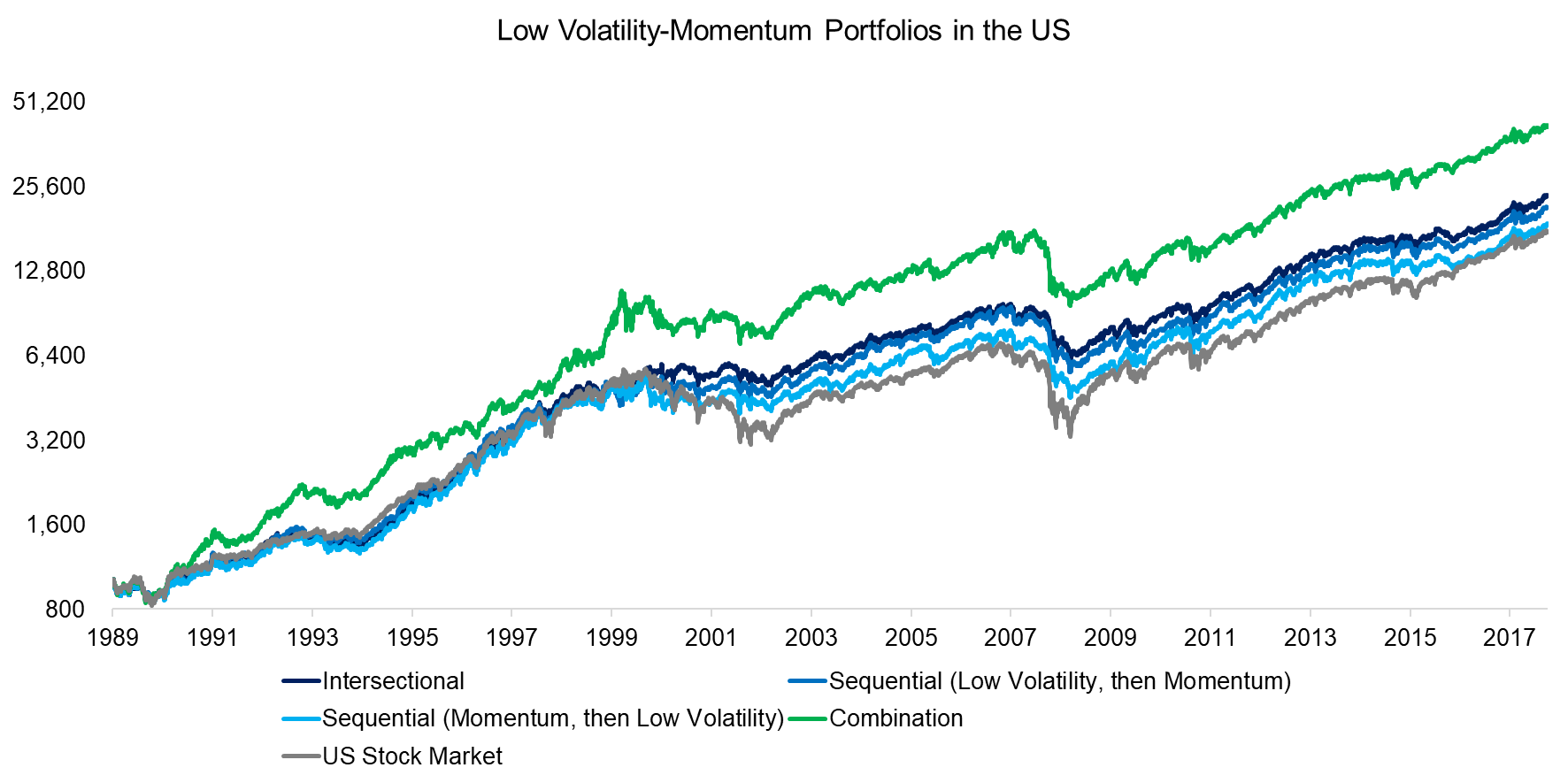
Source: FactorResearch
It is interesting to explore whether the LOVM portfolios outperformed the stock market consistently over time or only during certain periods. Therefore, we calculate CAGRs per decade and observe that most of the positive excess returns were generated from 2000 to 2010, where the stock market provided almost no return due to the tech bubble implosion in 2001 and the great financial crisis in 2008 to 2009.
The Combination portfolio is only one that consistently outperformed the market, although it was also the most volatile. The Low Volatility and Momentum portfolios were highly concentrated given that they represent only 5% of the stocks in the universe. They exhibited a relatively low correlation of 0.49 over the last 30 years and even periods of negative correlation, which provided attractive diversification benefits.
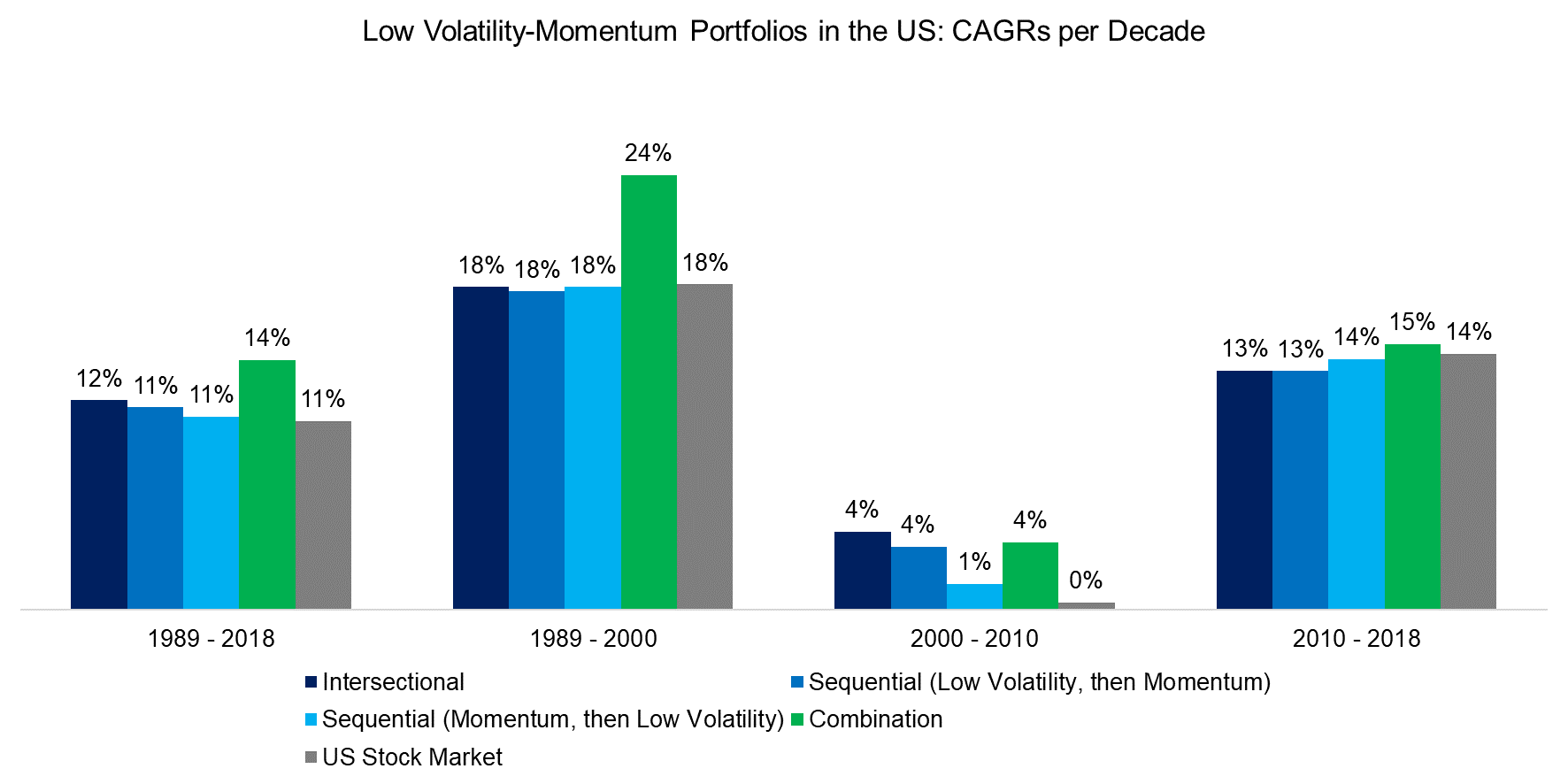
Source: FactorResearch
Investors primarily allocate to Low Volatility strategies for reducing equity risk and expect lower volatility and drawdowns. The worst point in the US stock market in the last three decades was reached during the global financial crisis in 2009, where LOVM portfolios experienced significantly lower drawdowns than the stock market.
Investors familiar with factor performance might be surprised by the reduced drawdowns given that the long-short Momentum factor crashed in 2009. However, the factor crashed only when stock markets started recovering and most of the negative excess returns can be attributed to the short portfolio.
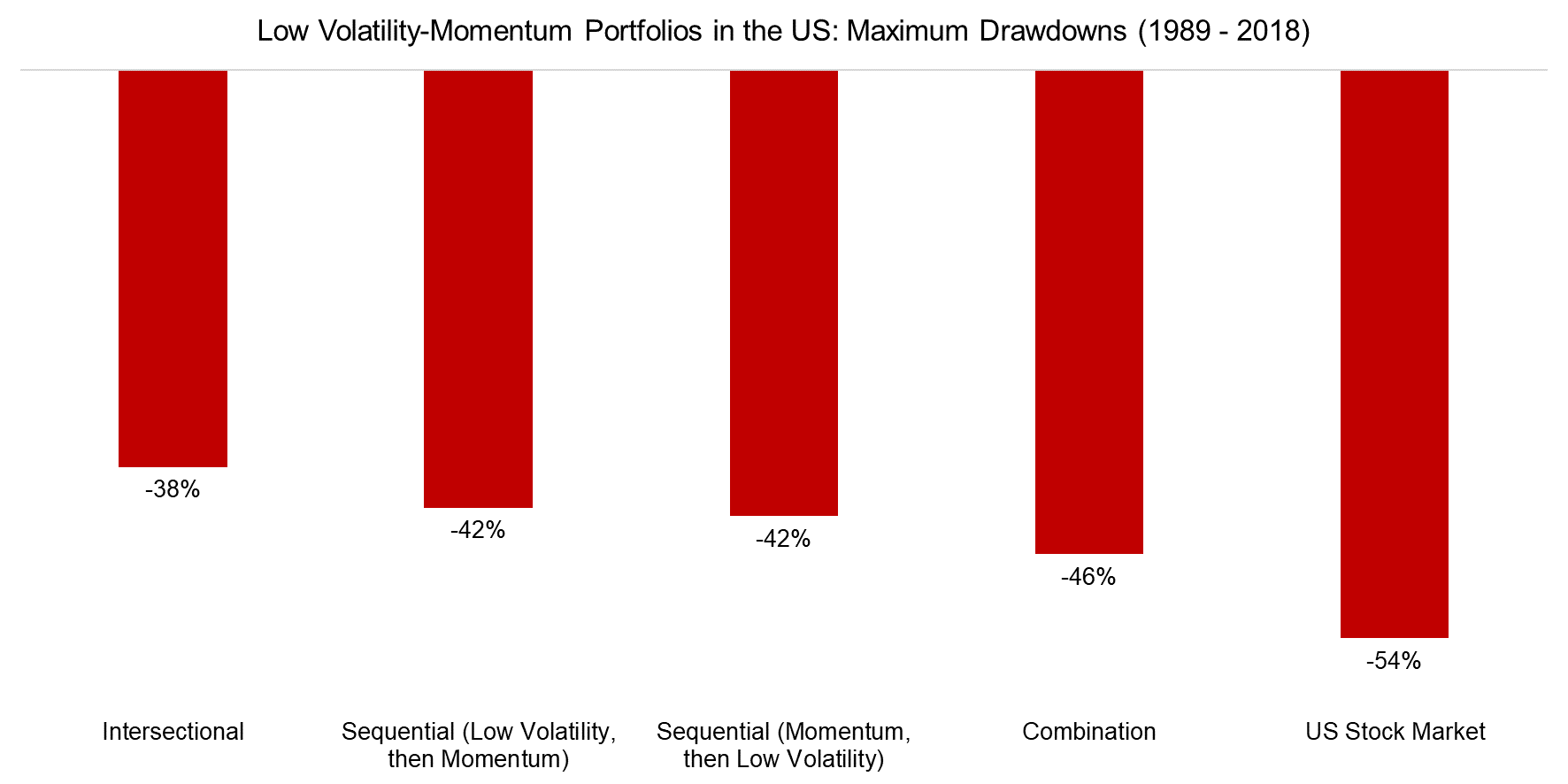
Source: FactorResearch
BREAKDOWN BY SECTORS
Next, we analyse the LOVM portfolios by sectors, which highlights significant differences to the US stock market. Broadly-speaking the portfolios created via the Intersectional and Sequential models were comparable and featured overweights in staples, utilities, and real estate as well as underweights in materials and technology.
In contrast, the Combination portfolio was more differentiated and exhibited a significant overweight to the utility and an underweight to the financial sector, which can be attributed to the Low Volatility respectively Momentum factor.
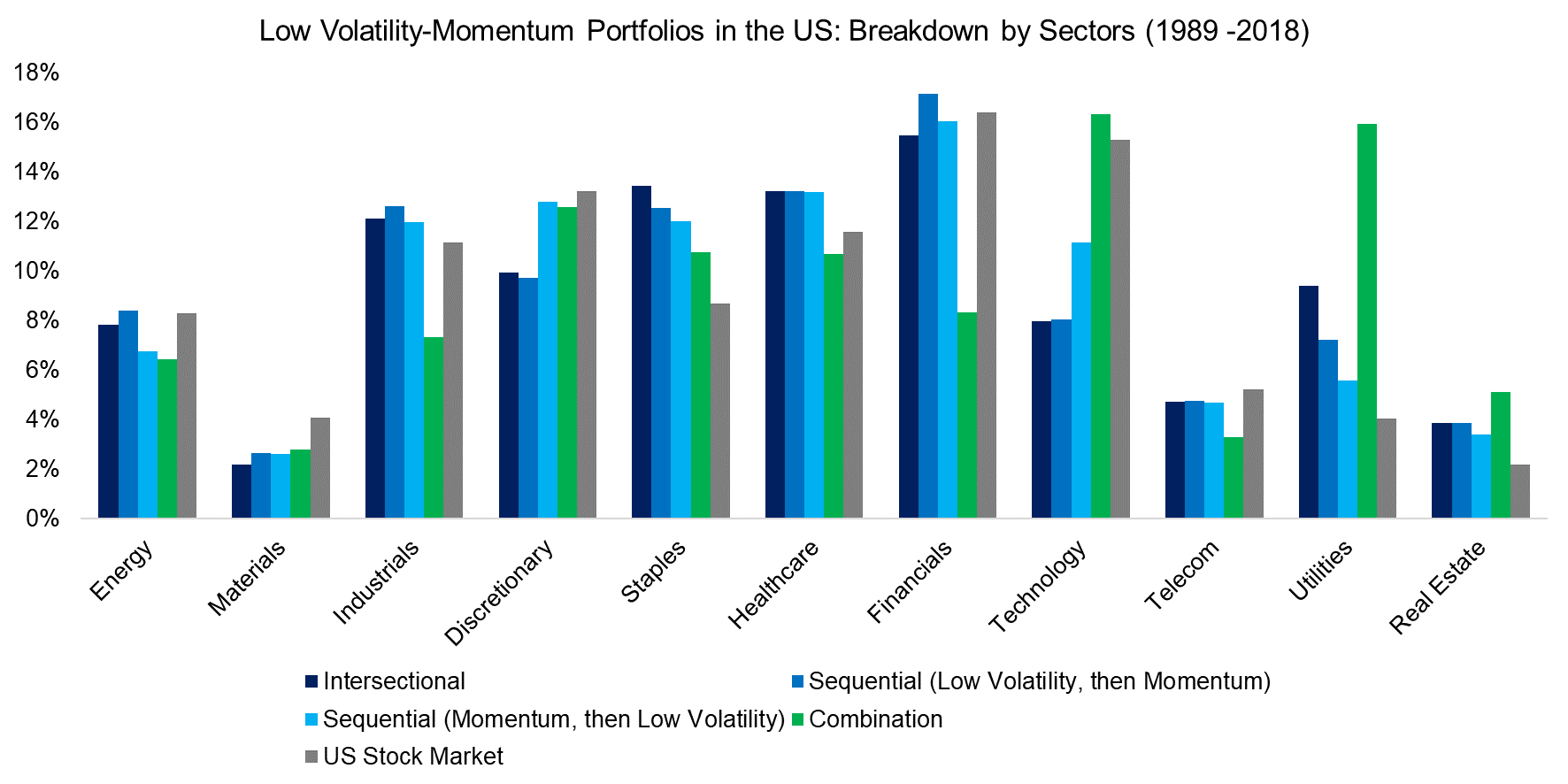
Source: FactorResearch
VALUATION OF LOVM PORTFOLIOS
Finally, we investigate how the valuation of LOVM portfolios has changed over time. We observe that all portfolios are trading significantly more expensive than their 30-year average as well as the stock market when measuring the valuation with median price-to-book multiples.
It is interesting to note that most of the multiple expansion is from the Momentum and not the Low Volatility factor. Investors are frequently concerned that low-risk stocks have become expensive as many of these are from bond-proxy sectors like real estate or utilities, which benefitted from decreasing interest rates. Although these have increased in valuation compared to their historical average, it is currently far less then Momentum stocks, which include a meaningful amount of expensive technology firms.
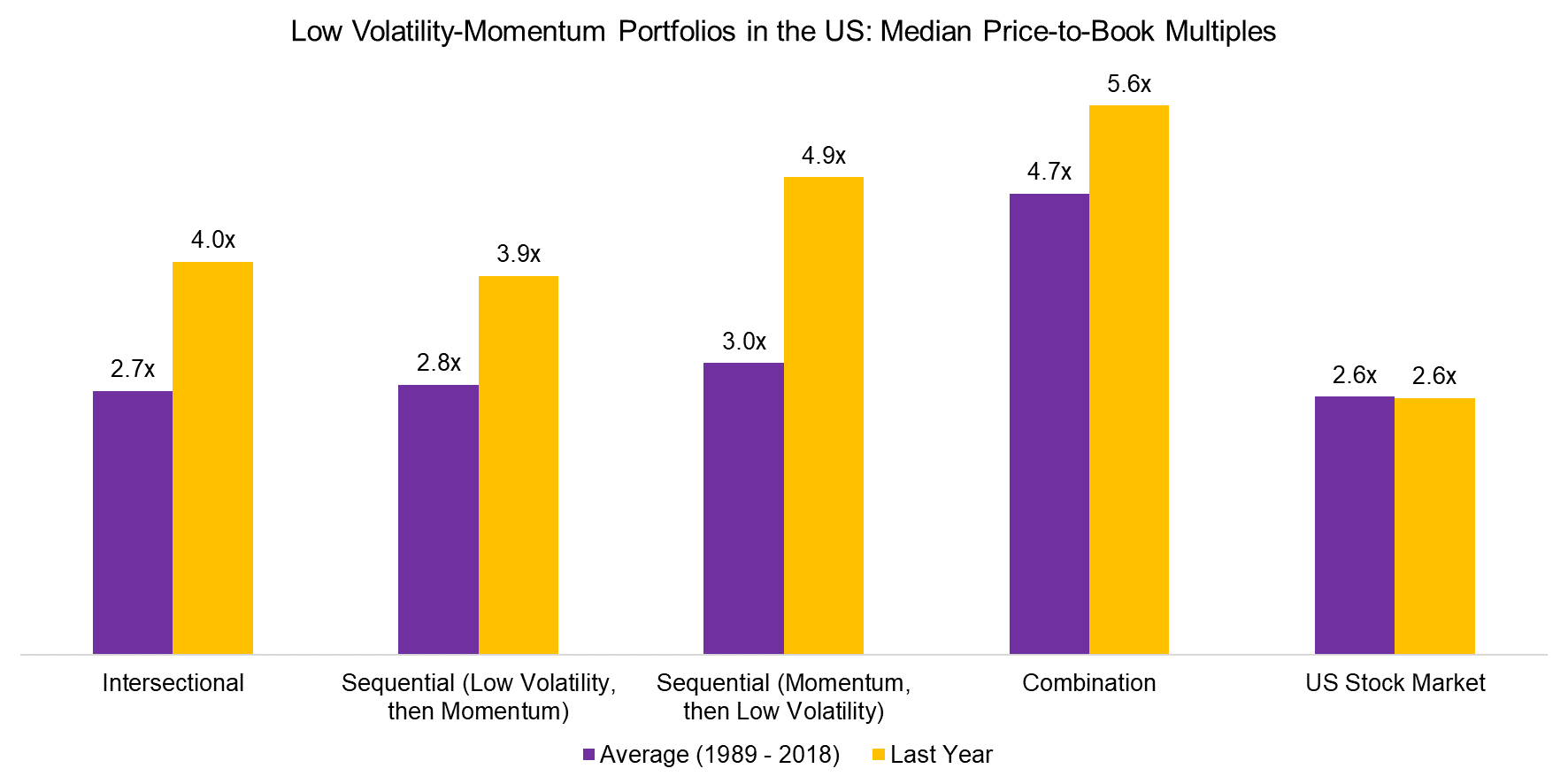
Source: FactorResearch.
FURTHER THOUGHTS
Given the attractive absolute and risk-adjusted returns of LOVM portfolios, it is surprising that currently there is no ETF on the market that offers this strategy. The ticker LOVM is still available.
However, investors intrigued by the strategy might question if they should be wary of performance chasing. Aside from perhaps being less emotionally painful to hold than other factor combinations, there are few arguments for why this multi-factor portfolio is superior to others such as a Value-Momentum combination.
RELATED RESEARCH
ABOUT THE AUTHOR
Nicolas Rabener is the CEO & Founder of Finominal, which empowers professional investors with data, technology, and research insights to improve their investment outcomes. Previously he created Jackdaw Capital, an award-winning quantitative hedge fund. Before that Nicolas worked at GIC and Citigroup in London and New York. Nicolas holds a Master of Finance from HHL Leipzig Graduate School of Management, is a CAIA charter holder, and enjoys endurance sports (Ironman & 100km Ultramarathon).
Connect with me on LinkedIn or X.

